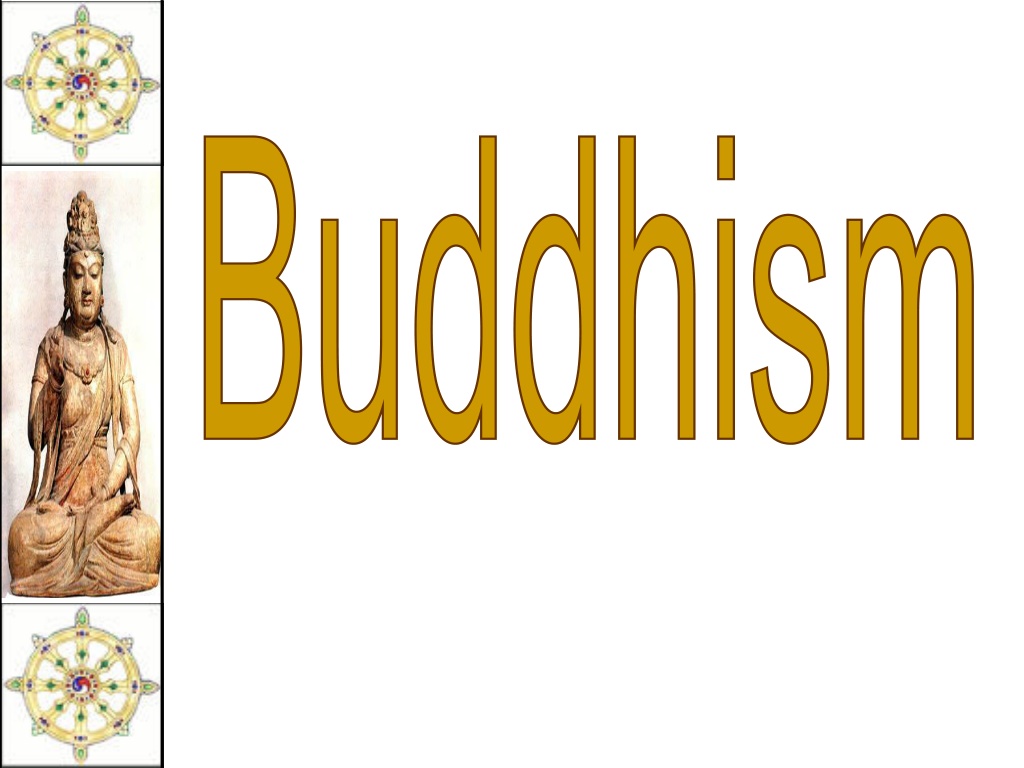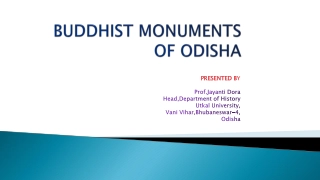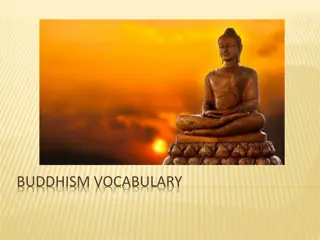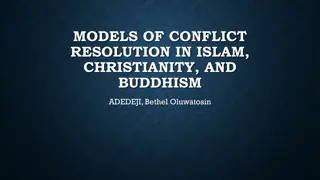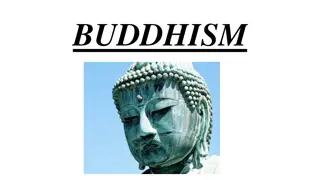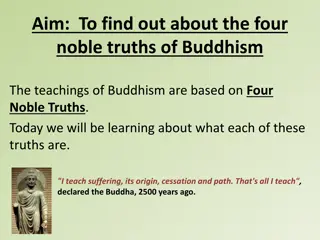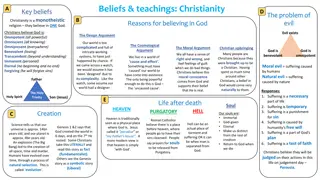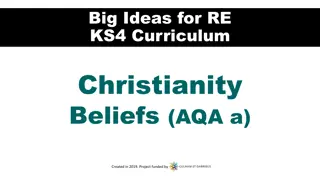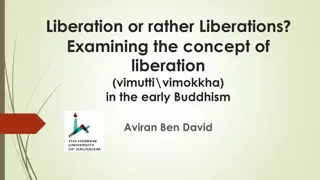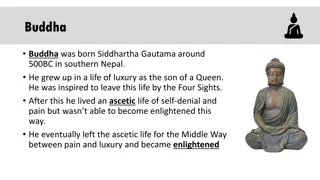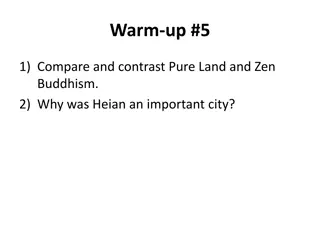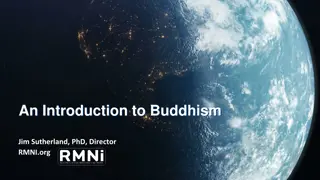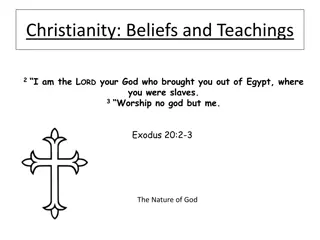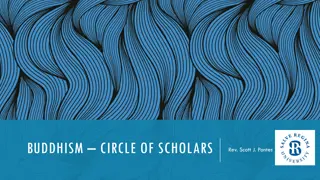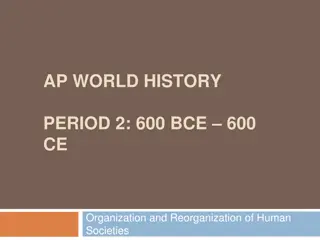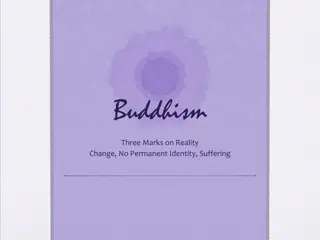Understanding Buddhism: Teachings, History, and Beliefs
Explore the essence of Buddhism through its teachings, history, and the story of Siddhartha Gautama. Learn about the Four Noble Truths, the concept of nirvana, and the Eightfold Path to achieve enlightenment. Compare Buddhism with Hinduism to understand the differences and similarities between these ancient religions rooted in South Asia.
Download Presentation

Please find below an Image/Link to download the presentation.
The content on the website is provided AS IS for your information and personal use only. It may not be sold, licensed, or shared on other websites without obtaining consent from the author. Download presentation by click this link. If you encounter any issues during the download, it is possible that the publisher has removed the file from their server.
E N D
Presentation Transcript
Objectives Study Buddhism and its teachings, history, and beliefs of practitioners. Compare aspects of Buddhism and Hinduism.
The essence of Buddhism The middle way of wisdom and compassion. 2,500 year old tradition. The 3 Jewels of Buddhism: Buddha, the teacher. Dharma, the teachings. Sangha, the community.
Siddhartha Gautama (563-483 BCE) Born in NE India (Nepal). Raised in great luxury to be a king. At 29 he rejected his luxurious life to seek enlightenment and the source of suffering. Lived a strict, ascetic life for 6 yrs. Rejecting this extreme, sat in meditation, and found nirvana. Became The Enlightened One, at 35.
What is the fundamental cause of all suffering? Desire! Therefore, extinguish the self, don t obsess about oneself.
Four Noble Truths 1. There is suffering in the world. To live is to suffer. (Dukkha) The Buddha found this out when he was young and experienced suffering and death in others.
Four Noble Truths 2.The cause of suffering is self-centered desire and attachments. (Tanha)
Four Noble Truths 3.The solution is to eliminate desire and attachments. (Nirvana = a state of perfect happiness)
Four Noble Truths 4. To reach nirvana, one must follow the Eightfold Path.
Eightfold Path Nirvana The union with the ultimate spiritual reality. Escape from the cycle of rebirth.
Mandala: spiritual and ritual symbol representing different aspects of the universe and life https://www.youtube.com/watch?app=desktop&v=WBrYUlOYK0U Sand mandala: Tibetan Buddhist ritual Mandalas are of profound symbolic value in Tantric Buddhism and are regarded by some as sacred. They can take a variety of forms: from simple diagrams and elaborate paintings on cloth, to complicated patterns of coloured sand and large three dimensional carved structures. Sand Mandalas represent the universe and act as an architectural blueprint of the enlightened mind. They can also function as a contemplative aid in visualisation meditation. Mandalas often refer to secret Tantric doctrine and highlight the ideals of the Buddhist path which includes putting an end to suffering, attaining enlightenment and understanding reality through the Wisdom of Emptiness. At the heart of this medicine mandala is a lotus throne and on it is a sacred medical text. Seated within the petals of a lotus flower are the Eight Medicine Buddhas, who came into the world to save sentient beings from the five degenerations: shortened life-span, delusions, degenerate persons, time and wrong views. In the outer sections the disciples of the Medicine Buddhas are represented by symbols. A rare opportunity to observe the creation and offering of a "Mela" or Medicine Mandala, made from tiny grains of vibrantly coloured sand, with Tibetan Buddhist monks from the Tashi Lhunpo monastery in India. Sand Mandalas are unique to Tibetan Buddhism, representing an architectural blueprint of the enlightened mind, functioning - among other things - as a contemplative aid in visualisation meditation. Part of Tibet's Secret Temple: Body, Mind and Meditation in Tantric Buddhism: http://wellcomecollection.org/secrettemple Find us on Facebook: - http://www.facebook.com/wellcomecollection Follow us on Twitter: - http://twitter.com/explorewellcome See us on Instagram: - http://instagram.com/wellcomecollection
Types of Buddhism Therevada Buddhism Mahayana Buddhism Tibetan Buddhism Zen Buddhism
Theravada Buddhism The oldest school of Buddhism. The Way of the Elders or the Small Vehicle. Found in southern Asia. The monastic life is the best way to achieve nirvana. Focus on wisdom and meditation. Goal is to become a Buddha, or Enlightened One. Over 150 million followers today.
Mahayana Buddhism The Great Vehicle Founded in northern Asia (China, Japan) Buddhism for the masses Seek guidance from Bodhisattvas, wise beings: persons who are able to reach nirvana but delays doing so out of compassion in order to save suffering beings Goal: Not just individual escape from the wheel, but the salvation of all humanity through self-sacrifice of those enlightened few
Tibetan Buddhism The Diamond Vehicle. [Vajrayana] Developed in Tibet in the 7c CE. A mix of Theravada and Mahayana. Bodhisattvas include Lamas, like the Dalai Lama.
The Dalai Lama
Zen Buddhism The Meditation School. Seeks sudden enlightenment [satori] through meditation, arriving at emptiness [sunyata]. Use of meditation masters [Roshi]. Beauty, art, and aesthetics: Gardens Archery Tea ceremony Calligraphy
Relieve Stress & Meditate: Get a Mantra: a word or sound repeated to aid concentration in meditation! Ohm...mani...padme...hung... Hail to the jewel in the lotus!
